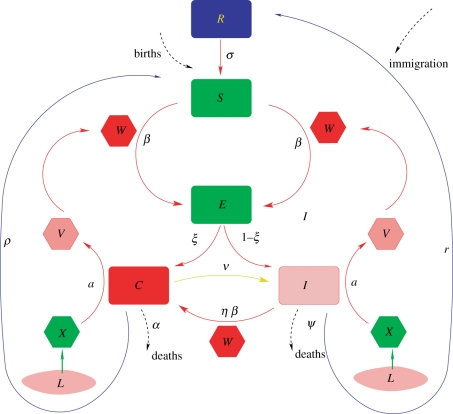Figure 2.
Coupled mosquito–human model of malaria dynamics. The population is subdivided into a number of classes. In particular, two types of infected individual are considered: those who present symptoms and therefore receive some sort of clinical treatment (C), and those who acquire asymptomatic infection (I) but are nevertheless infectious and can transmit the parasite to the vector. A recovered class (R) consists of individuals who have cleared parasitaemia, or have too low a level of parasitaemia to effectively infect the vector. The replenishment of susceptibles through immigration or births (B) and individual losses owing to mortality—or more generally, population turnover (δ)—are considered to balance each other so that the total population N remains constant. A constant maximum size of the worker population and their dependants in the tea estates supports this assumption [15]. The coupling to the mosquito component of the model occurs through the ‘force of infection’ (β), the per capita rate at which susceptible individuals become infected. This rate contains two terms to allow for two different sources of infection, for local and external transmission, respectively (electronic supplementary material). The local force of infection depends on the number of infected mosquitoes W, and the mosquito population is subdivided into larvae (L), and adults, with uninfected adults (X) becoming exposed (V) when they bite an infectious human (electronic supplementary material). Only a fraction of infections in humans (ξ) fully develops severe malaria symptoms and then receives clinical treatment (C). Asymptomatic but infectious individuals (I) can present a relapse of severe malaria symptoms if they are bitten again, but the per capita transmission rate (β) of this process is decreased by a factor η. The clearance or recovery rate for treated infected and sick (C) and non-treated infected individuals (I) are ρ and r, respectively. Recovered individuals in R lose immunity at rate σ and return to S with a relaxation time that depends on mosquito exposure (see electronic supplementary material for details).

